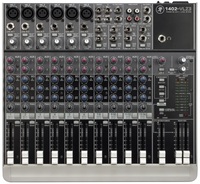Line Level Audio Feeds to Consumer Camcorders
 Audio coming from a mixing board is usually at 600 ohm line level, which is a much hotter and stronger signal than mic level. Although the better cameras on the market have selectable inputs for mic level or line level, the standard consumer camcorders only accept mic level external input when used as a live camcorder; when the camcorder is used as a DVR it will accept external line level video and external line level audio via RCA jacks. When the camcorder is functioning as a camcorder, the RCA line level inputs are disabled.
Audio coming from a mixing board is usually at 600 ohm line level, which is a much hotter and stronger signal than mic level. Although the better cameras on the market have selectable inputs for mic level or line level, the standard consumer camcorders only accept mic level external input when used as a live camcorder; when the camcorder is used as a DVR it will accept external line level video and external line level audio via RCA jacks. When the camcorder is functioning as a camcorder, the RCA line level inputs are disabled.
Therefore, to feed line level audio into a simple camcorder (which is mic level), we need to reduce the signal by 30 to 50 dB. The 50 dB setting is technically the correct one to use, but in the real world there is some latitude.
Some portable mixing boards have a switch to reduce their outputs from line to mic level. You can't ask for more convenience than that!
Otherwise, one needs to insert a pad or attenuator between the output of the mixing board and the input of the camcorder. Shure makes a 50 dB line to mic Attenuator. Audio Technica offers a switchable -10, -20, -30 dB pad. HOSA offers a –20 dB, -30 dB, -40 dB switchable pad. Any of these devices will work, since the camcorder input does offer some range with its onboard gain or volume controls.
Sometimes when you feed from a mixing board, the DC interference at the mic input jack may be a problem. Sometimes it may not. It all depends on the design of the mix board.
To play it safe, use an input cable or adapter that features DC blocking. If the camera and the mixer both need to power from AC, try to plug them into the same power strip to reduce the chances of a ground loop.
So far, we have only discussed the logistics of getting an audio signal into the camcorder. Now, a few comments on what that signal should be.
There is an old computer programmer’s expression that goes "garbage in, garbage out." That applies to production sound, as well. It does no good to have a clean signal entering the camcorder if that signal is worthless to begin with!
Just because you are recording on an inexpensive medium is no excuse to be lazy with technique. Small camera or not, a tripod and lights will still make the difference between a home movie and a professional product. And proper microphone deployment and mixing are still essential if you want a professional sounding track.
Use the same mics and techniques that you would on a big budget show.
Mic your subjects from close overhead with a boompole, and use high quality ENG or full condenser shotgun mics.
If using lavaliers or wireless mics, pay careful attention to proper placement and rigging. Check for clothing and wind noise.
Adjust any cables that function as antennas. If possible, mount your receiver as close to the action as possible, any pay careful attention to antenna line of sight.
Mounting a radio receiver on a consumer camcorder can be tricky, since these cameras are not as well shielded as their professional large format counterparts. Camcorders tend to produce a lot of RF interference near their viewfinders and near the recording heads. Try moving the receiver around to find a "sweet spot" that is free of buzz or hum.
If your camcorder is equipped with an auto gain control, then your best strategy for eliminating or reducing the "hunt for some sort of noise to amplify" is to make sure that you feed a well mixed or well chosen signal to the camera.
Think of it in terms of working with a still camera that has auto light metering. Frame up on a high contrast or unusual lighting condition and you get horrible exposures. But compose a scene with some highlights, shadows, and a lot of middle tones and the exposure come out beautiful.
It's the same way with sound. Feed your camcorder a strong signal with dialogue dominating over ambience; or sound effects dominating over background noise -- and the resultant soundtrack will be fine.
By the way, a neat trick when you are recording in mono and using a camera with manual audio settings is to use a Y cable and bracket your exposure, so to speak. Split the monaural output to both XLR inputs, and offset the volume so that one track is better for soft passages while the other track is adjusted down for the louder stuff.
In conclusion, using a cheap camera is no excuse for cheap sound. Do it right, and your audience will never know if you shot with a professional rig equipped with XLR inputs, or a consumer rig that everyone else believed was limited to the dinky plastic mic that it came equipped with.
